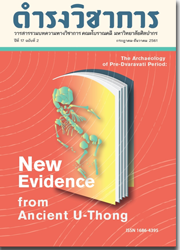Physical Environment for Settlement Suitability in the Prehistoric Period: Middle to Lower Pasak Watershed
Keywords:
GIS, Spatial Analysis, Pasak watershed, Prehistoric Settlement and Physical environmentAbstract
This paper aimed to study the relationship between physical environment factors and archeological sites in the middle to lower area of the Pasak watershed using the geographic information system (GIS). Spatial analysis techniques and statistical methods were used to analyze the influence of physical environmental factors for settlement suitability of prehistoric humans. The physical environment factors including 1) elevation, 2) slope, 3) aspect, 4) soil fertility and 5) stream distance were used in a correlated analytical study with archeological sites which covered period 1 (3,300 - 3,000 BP), period 2 (2,900 - 2,800 BP) period 3 (2,300 - 1,600 BP) and period 4 (1,600 - 1,500 BP). Each of the correlation results between physical environment factors and archeological sites were derived a probability value of an occurred archeological site. The probability values of the archeological sites were analyzed to explain the suitability of prehistoric archeological sites. The results indicated that soil fertility was the most significant factor and slope, elevation and stream distance were consecutively significant factors for settlement suitability. Furthermore, this study also noted that the settlement selection decisions of prehistoric humans were similar to modern humans. The settlement selection decisions show that they preferred to settle in the low terrain areas rather than in the high terrain areas which is consistent with high soil fertility that was usually found in the low terrain areas.
References
ทิพย์วรรณ วงศ์อัสสไพบูลย์, 2558. “ข้อมูล สารสนเทศ และความรู้เพิ่มใหม่จากการขุดค้นแหล่งโบราณคดีบ้านโป่งตะขบ ตําบลวังม่วง อําเภอวังม่วง จังหวัดสระบุรี พ.ศ.2557.” ใน สุรพล นาถะพินธุ (บรรณาธิการ), ข้อมูล สารสนเทศ และความรู้เพิ่มใหม่จากงานวิจัยโบราณคดีลุ่มแม่น้ำป่าสัก (หน้า 59-81). กรุงเทพฯ: สนับสนุนทุนวิจัยโดยทุนส่งเสริมกลุ่มวิจัย (เมธีวิจัยอาวุโส) ของสํานักงานกองทุนสนับสนุนการวิจัย (สกว.).
สุรพล นาถะพินธุ, 2558ก. “โบราณคดีของพื้นที่ซับจําปา.” ใน ภูธร ภูมะธน (บรรณาธิการ), ซับจำปา พิพิธภัณฑ์ซับจำปา จังหวัดลพบุรี (หน้า 16-31). กรุงเทพฯ: บริษัท อมรินทร์พริ้นติ้งแอนด์พับลิชชิ่งจํากัด (มหาชน).
สุรพล นาถะพินธุ, 2558ข. “ข้อมูล สารสนเทศ และความรู้เพิ่มใหม่จากการขุดค้นแหล่งโบราณคดีบ้านโป่งตะขบ ตําบลวังม่วง อําเภอวังม่วง จังหวัดสระบุรี ระหว่าง พ.ศ.2561-2556.” ใน สุรพล นาถะพินธุ (บรรณาธิการ), ข้อมูล สารสนเทศ และความรู้เพิ่มใหม่จากงานวิจัยโบราณคดีลุ่มแม่น้ำป่าสัก (หน้า 1-37). กรุงเทพฯ: สนับสนุนทุนวิจัยโดยทุนส่งเสริมกลุ่มวิจัย (เมธีวิจัยอาวุโส) ของสํานักงานกองทุนสนับสนุนการวิจัย (สกว.).
Clarke D. L., 1977. Spatial Archaeology. Boston: Academic Press.
Endale M., 2003. Cropland Soil Erosion Prediction using WEPP Model (A case study on hillslope in Lom Kao Districy, Thailand). Master’s dissertation. InternationalInstitute for Geo-Information Science and Earth Observation, Enschede, The Netherlands.
Hillel D., 2005. “Civilization, role of soils.” In D. Hillel, J.H. Hatfield, D.S. Powlson, C. Rosenzweig, K.M. Scow, M.J. Singer, and D.L. Sparks (eds.), Encyclopedia of Soils in the Environment Volume 1 (pp. 199-204). Elsevier/Academic Press.
Ridges M., 2006. “Regional Dynamics of Hunting and Gathering: An Australian Case Study Using Archaeological Predictive Modeling” In M.W. Mehrer and K.L. Wescott (eds.), GIS and Archaeological Site Location Modeling (pp. 121-143). Taylor & Francis.
Soonius C.M. and L.A. Ankum, 1990. Ede, II: Archaeologische Potentiekaart. Stichting RAAP, Amsterdam, The Netherlands.
Verhagen P., 2006. “Quantifying the Qualified: The Use of Multicriteria Method and Bayesian Statistics for the Development of Archaeological Predictive Models” In M.W. Mehrer and K.L. Wescott (eds.), GIS and Archaeological Site Location Modeling (pp. 191-216). Taylor & Francis.
Downloads
Published
Issue
Section
License
บทความนี้เป็นผลงานของข้าพเจ้าแต่เพียงผู้เดียว และ/หรือเป็นผลงานของข้าพเจ้าและผู้ร่วมงาน ตามชื่อที่ระบุในบทความจริง และเป็นผลงานที่มิได้ถูกนำเสนอหรือตีพิมพ์ที่ใดมาก่อน




